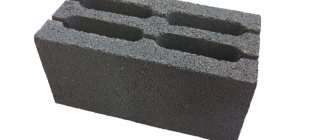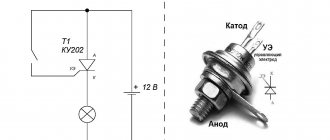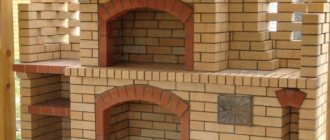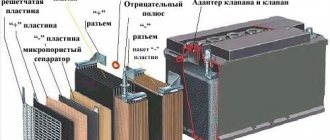How much does a brick weigh? Table of weights of all types of bricks.
The weight of a brick depends on the material from which it is made, its purpose, size and shape. The main characteristics of such a building material include size, water absorption, frost resistance, thermal conductivity and, of course, weight.
Brick weight.
However, this does not mean that the heavier the material, the stronger or more durable it is. Bricks are produced from different types of raw materials and in different ways. Firing is carried out at certain temperatures. The properties of the material that correspond to its purpose are considered paramount, and only then comes such an auxiliary characteristic as mass.
What is the size and weight of facing bricks?
The properties and weight of facing bricks are determined by the material from which it is made. The main raw material is clay, which has been fired. It is the density of the clay and the dimensions of the product that determine the weight of the stone. Facing bricks have more precise dimensions than simple ones for masonry. An important requirement is that its front surface must have an aesthetic appearance. The variety of applications forces manufacturers to produce a wide range of colors. Its two sides - the poke and the spoon - must have a smooth appearance.
There are several main types of bricks for cladding:
- Ceramic. It can be solid or hollow. Voids are necessary for better heat retention. They significantly lighten the weight of the stone. The surface can be varied - glazed, engobed. Combined options are in demand: one color, another texture. Weight and dimensions of facing bricks: 250x120x65 (from 2 to 2.7 kg depending on hollowness) 250x120x65 (3.65 kg, solid), 250x85x65 (Euro) (2.15 kg, hollow).
- Clinker facing brick. This is a modern, durable version of the simple brick. Good wear resistance allows it to be used in areas of intensive use - plinth, doorways, garden paths. But it is denser, which means it is heavier and less thermally conductive. Weight and dimensions of facing bricks: 250x120x65 (4.2 kg, solid), 250x90x65 (2.25 kg, hollow), 250x60x65 (1.75 kg, hollow), 528x108x37 (3.75 kg, elongated brick).
- Facing hyperpressed brick. It is produced using a non-firing method using impressive pressure. Composition: limestone with cement, without sand and clay. The stone produces a beautiful “ragged chip”, which designers skillfully use. The brick is durable and frost-resistant. 250x120x65 (4.2 kg), 250x60x65 (2 kg), 250x90x65 (4 kg), 250x120x88 (6 kg).
- Sand-lime brick is leaving the facing brick market. It does not meet aesthetic standards and demands. Was in demand due to a shortage.
Standard brick sizes are in greatest demand. The standard size of a single facing brick is 250x120x65 (proportion 1:1/2:1/4.0) and one and a half - 250x120x88. The standard originated in 1927. The double size is less used - 250x120x138. Other options are less common. The dimensions of facing bricks comply with GOST and SNiP (construction rules). This allows you to work efficiently and reduces material consumption. A legally manufactured and sold batch has accompanying documentation, which may indicate permissible errors.
Dimensions and weight according to GOST
Standard sizes of single, one-and-a-half and double products:
When designing buildings and structures, all characteristics are taken into account, including overall dimensions and weight of red brick.
Manufacturing products according to uniform dimensions allows the designer to easily select elements of a certain format for construction or cladding, and knowing their approximate weight allows them to correctly calculate the load of the structure being built on the foundation.
It will be possible to purchase the material from any manufacturer and at any time after the project has been prepared.
Standard sizes of red brick in normal (regular) 1NF format:
- length – 250 mm;
- width – 120 mm;
- height – 65 mm.
It is the dimensions of single elements, provided for by GOST, that are a kind of reference point - i.e. a material with other parameters will have a different marking instead of 1NF, where the number indicates its proportions to the single one.
So, the size of a one-and-a-half red brick will already be 250 × 120 × 88 mm, and will be designated as 1.4 NF. Products of these formats are produced both as regular and facing ones.
The list of sizes of facing red bricks can be supplemented with euro format products (0.7NF, 250×85×65 mm), and ordinary ones with double elements (2.1NF, 250×120×138 mm).
Dimensions of red brick in Euro format
Thin facing material (euro) will help reduce financial costs for cladding, and large stone (double) will significantly speed up the process of building a house.
Many people are often interested in the question of how thick red brick is. For materials of basic formats (single, one and a half and double) it is standard - 120 mm.
The exception is euro-sized elements, the width of which is reduced to 85 mm.
Deviations from standard sizes
According to GOST, the maximum permissible deviations from standard dimensions on one element (regardless of the format) are:
- length ±4 mm;
- width ±3;
- thickness ±2 mm for front and ±3 for regular material.
Red brick weight according to standard
GOST does not reflect information about how much a single or red brick of other dimensions weighs - the standard only indicates classes of material based on average specific gravity.
Dimensions and weight of kiln bricks
Standard dimensions and weight of oven bricks
The modern building materials market offers the consumer a very wide selection of different types of bricks. Each of them differs in its technical characteristics and scope of application. But no matter how wide the range, you cannot use ordinary silicate blocks for the construction of stoves and fireplaces - here you need another material that can withstand temperatures of at least 1000 °C. Stove blocks also come in different brands. And in order to choose the best option for constructing a structure, it is necessary to take into account the main parameters of the raw materials - the weight and dimensions of the stove brick. What options do manufacturers offer?
How much does a stove brick weigh?
The weight of brick blocks is the main parameter, which is strictly regulated by GOST or specifications for a specific production. The weight of the kiln brick directly affects the load that will be placed on the foundation in the future. In addition, knowing this indicator, you can calculate the total consumption of raw materials, the mass of the pallet and 1 m 3 of material.
The types, purposes, sizes, and shapes of products are different, and accordingly, their weight also varies. And even if you weigh bricks of the same brand, but taken from different batches, the indicators may differ, which, in fact, is the norm. Having weighed a certain number of samples, we will still get the average mass indicated by GOST, SNIP or TU. Therefore, when wondering how much a stove brick weighs, we mean background information about its standard specific gravity.
Manufacturers today offer stove blocks weighing from 2 to 4 kg. Although regulatory documents establish the specific gravity of oven bricks as 3.7 kg. The final weight of the products is influenced by the characteristics of the kiln brick and their size.
What are the dimensions of stove bricks?
Over the many years of existence of kiln bricks on the construction market, a certain classic example of a block has been formed, which is convenient for the master to hold in his hands when working, and which ultimately gives a leveled masonry.
The standard size of a stove brick has the following parameters: length – 250 mm, width – 120 mm, height – 65 mm. And if in the process of laying bricks it is necessary to use not the whole product, but only part of it, the block is cut with special tools or split with a strong blow.
The size of the brick for the stove may differ from standard indicators. For example, some manufacturers offer customers blocks measuring 230*113*65 mm.
Main types of bricks
Today, there are two main types of brick blocks that can be used for laying a stove:
- ceramic;
- fireplace
Ceramic bricks, which are made using red clay, can only be produced by firing. If we talk about the advantages of this type of material, then this is, of course, full compliance with GOST standards. This type of brick is usually used to build the upper part of the chimney - where the heat of the stove will not be so strong.
Fireplace bricks can be divided into four types: quartz (made from sandstone and quartz chips with a slight addition of clay), basic (made from a lime and magnesium mixture), carbon (produced by pressing coke and graphite chips) and refractory fireclay (the main material for making clay). For the manufacture of stoves or fireplaces, only quartz and fireclay are used.
Kiln brick weight
The building materials market offers a fairly wide range of bricks, but the construction of stoves, fireplaces and chimneys requires material that can withstand direct exposure to fire many times over. Special bricks for the stove are produced for the purpose of operation at a temperature of at least 1000°C - these are the conditions for burning wood in the firebox.
What types of oven bricks are there?
The range of this building material consists of several types:
- Red stove brick (a mixture of quartz or sand with clay)
- Refractory red brick (a mixture of quartz or sand with refractory clay)
- Carbon brick
- Basic brick
Red brick weight
The weight of any red brick may vary. Depending on the density of the product and with the same dimensions, the weight of a red solid brick may well differ, for example, from a red stove brick, and even more so from a hollow one. Knowing the density and format of a brick, you can calculate its average weight using the formula m=a*b*c*p, where m is the mass of the brick, a, b and c are the length, width and height of the brick, respectively, p is the density of the brick.
For example, judging by the above markings of solid clinker bricks, its weight will be 250x120x65x2.0 = 3.9 kg. Considering that solid bricks include products with a void volume of no more than 13 percent, we subtract these percentages from the result and determine that the weight of our brick is from 3.39 to 3.9 kg. Typically, the average weight is 3.5 kilograms.
In a hollow brick, cavities and pores reach up to 45 percent of the volume, respectively, its weight will be significantly lower than a solid brick and much less than a stove brick. It must be understood that in such calculations it is necessary to take into account errors associated with the storage of bricks - its dryness, etc.
According to GOST 530-2012, the weight of red solid single brick of density class 2 should be in the range of 3.3-3.7 kg. The weight of a single hollow brick of density class 1.4 is 2.3-2.7 kg. The weight of red stove brick is on average 3.7 kg.
How much does a red brick weigh?
For the use of this building material, the indispensable properties are heat retention, moisture resistance, strength and, of course, its weight. There are several types of red brick, but its most optimal shape and size is 250 * 120 * 65 millimeters.
With these parameters, the mass of one brick varies within 4.3 kilograms. But with all this, more bulky bricks, which have the appearance of a block, can reach a mass of 25 kilograms. After all, the weight of a brick depends directly on the composition of the mixture and the dimensions of the building material.
It should also not be argued that if a brick has a bulkier and heavier weight, then its strength is the highest. This is absolutely not true, because each type of brick is made using a special production technology and has a specific composition.
In addition, most bricks have different firing temperatures, which also significantly affects the weight of the brick. Undoubtedly, the mass of a brick is not its main characteristic, but it is not the most important one either.
How much does a solid red brick weigh?
This type of brick is used mainly in facing works. For example, in the construction of basement construction, masonry of fireplace equipment and other objects.
Very rarely, red solid brick is used in the construction of load-bearing walls due to the fact that it has poor functional hardness and strength.
In addition, solid red brick has a low level of heat retention.
For this reason, when building walls, it is necessary to thicken their layer into several bricks, which places significant pressure and load on the foundation of the house - the foundation.
The weight of such a brick varies depending on its dimensions and purpose. In its average value it has a result of 3.3 - 4.2 kilograms.
The building materials market is often replete with hollow red bricks. Such bricks are absolutely not suitable for load-bearing structures. It is used only for decorative and facing work on the facade of a building. The weight of such building material can be from 1.5 to 2.5 kilograms.
How much does a red stove brick weigh?
The stove type of brick is quite common in the construction of premises. It can be used in more common areas, since the physical characteristics of the brick allow such use.
Kiln bricks can be used to construct load-bearing walls and decorative work on the façade of a house. The mass of such a brick can be from 3.6 to 4 kilograms.
Types of material and container weight of bricks
How much does the furnace material weigh? There are many types of red brick - it can be hollow and solid, one- and two-layer, facing and stove.
- mass of one stone;
- amount of material in one pallet;
- total weight of one package.
Usually this data is enough for the buyer to calculate everything on his own. It should be taken into account that the weight of wooden containers is, as a rule, 30-40 kg. The material is formed into cubes so that it is easy to count the number of bricks on a pallet by simple multiplication . This helps both sellers and consumers, who are then able to quickly mentally calculate the amount of material purchased.
How much does a stove brick weigh?
If you decide to install a stove in your home, you need to pay attention not only to its design, but also to the choice of good material.
This material is usually red special brick for the stove, which is fireproof and can withstand temperatures up to 1800 degrees. To be sure that the purchased material has the required quality, it is useful to know how much a pallet of red stove bricks should weigh. In addition, the exact weight will help calculate the load on the foundation of the house.
Packing of bricks
The rules for forming pallets are described in GOST. Thus, laying can be done in a herringbone pattern, flat or on the edge, using a criss-cross dressing. Such a filled pallet weighs no more than 850 kg. This total mass consists of the weight of the bricks themselves and containers made of dense wood.
The building material is secured to the pallet using narrow metal strips, as well as, if necessary, a special stretch film that protects the bricks from temperature shrinkage.
Material of only one brand and type is always stored in one pallet ; pallets with the same type of stone are stored in single-tier stacks. The maximum height is two tiers , otherwise the material will be damaged under its own weight .
However, despite these requirements, manufacturing plants often follow their own rules for placing material on pallets, sometimes exceeding the permitted maximum packaging weight by several times.
Types of material and container weight of bricks
How much does the furnace material weigh? There are many types of red brick - it can be hollow and solid, one- and two-layer, facing and stove.
- mass of one stone;
- amount of material in one pallet;
- total weight of one package.
Usually this data is enough for the buyer to calculate everything on his own. It should be taken into account that the weight of wooden containers is, as a rule, 30-40 kg. The material is formed into cubes so that it is easy to count the number of bricks on a pallet by simple multiplication . This helps both sellers and consumers, who are then able to quickly mentally calculate the amount of material purchased.
To reduce weight and provide better thermal insulation, construction and cladding products have cavities - the more of them, the better the characteristics of the material. Thanks to this, the lightest specimens, half of which are occupied by voids, have a mass of 2.7 kg.
Kiln red brick is usually solid - this way it transfers heat much more efficiently. Accordingly, its weight is higher and amounts to 3.1-4 kg, if its size is equal to the established GOST - 250x123x65 mm. Usually 200-330 pieces fit on one pallet. As a result, the net weight of one pallet of red bricks should be from 660 to 1200 kg. Special refractory bricks for laying furnaces of the ShB-5, ShB-8 and ShB-24 brands weigh approximately the same. However, packaging with this type of material has a slightly larger mass due to the larger number of pieces on the pallet - it ranges from 1.25 to 1.3 tons.
Material selection
To make the stove efficient and durable, when choosing ceramic building products you need to pay attention not only to their weight, but also to the following properties:
- Almost perfect surface evenness. If defects, marks, and traces of impurities are visible on individual copies, then the quality of the entire batch is called into question.
- Same uniform red tint.
- Correct form . All edges must be straight, without bends, chips or gouges, and also of the same length so that the masonry turns out without flaws.
- The same mass of all stones.
Is it possible to use ordinary bricks for stoves?
For the construction of furnace elements that are not exposed to high temperatures, you can use red solid brick. How much does this material weigh? One standard copy of the product, which measures 250 x 120 x 65 mm, weighs 3.3-3.6 kg.
Technical characteristics and weight of bricks
When using a standard red stone, please note that it was without external defects - chips, cracks, shells.
The color of this material must be uniform over the entire surface. The dimensions and weight of the red block may be different if non-standard material is used, but one-and-a-half or double bricks.
The mutual perpendicularity of all planes must be observed, and the geometric dimensions must comply with the generally accepted standard.
How much does a red brick weigh?
The most common building material is red ceramic stone - experts estimate its share in the segment of piece elements at 90%. This popularity is explained by its excellent technical characteristics. An important parameter to consider when purchasing is the weight of the red brick.
It is a flattened rectangle made of clay with various impurities by firing in a special oven. In order to determine how much a red brick weighs, you need to know its other characteristics, first of all, its size and hollowness, as well as its purpose. Taking this into account, it is classified as follows:
1. By purpose it happens:
- Ordinary - used in the construction of internal and external walls with their subsequent plastering, for which it has special grooves on the spoon side.
- Facing (facing) – used in the construction of facade walls, pillars, arches and other things.
- Special (fireproof) - designed for rooms experiencing high temperature loads or with an aggressive environment (alkali, acid, background radiation, and so on). The weight of a single stove brick is 3.6–3.8 kg.
2. By size they are distinguished:
- Single – the most common size. One red ceramic brick 250x120x65 weighs from 1.8 to 4.0 kg.
- One and a half have a height of 88 mm.
- Double – 138 mm high.
3. According to their structure, ordinary and facing elements are divided into:
- Solid, which have a minimum of voids in the structure - up to 13%. Used for the construction of supporting structures (foundations, load-bearing walls). The weight of red solid brick, depending on its size, ranges from 3.6 to 4.5 kg.
- Hollow (warm). Thanks to the voids (their part ranges from 20 to 45% of the volume of the product), they create a layer of air that allows you to retain the heat accumulated in the building. A hollow brick weighs about 2.5 kg.
The table shows a lot of different types:
| By purpose and structure | Weight of 1 piece, kg | ||
| Single | One and a half | Double | |
| Private corpulenthollow | 3,3–3,62,3–2,5 | 4–4,33,0–3,3 | 6,6–7,24,6–5,0 |
| Facinghollowsolid | 2,1–2,73,6–3,7 | 2,7–3,24,2–6,0 | –– |
| Fireproof solid | 3,5–4,0 | – | – |
The weight of one cubic meter of ordinary and facing brick ranges from 675 to 1848 kg, special oven brick - 1,700 - 2,050 kg.
Please note when purchasing
- Large mass does not guarantee high quality material. In this case, the strength grade, thermal conductivity, and water absorption are of greater importance.
- It is better to purchase a product with a strength of M200, which is universal for various structures.
- It is recommended to take a stone from one factory batch and be sure to ask the seller for a quality certificate.
Sand-lime brick weight
Sand-lime brick is often called white because of its color. The weight of sand-lime brick differs from the weight of ceramic brick with the same dimensions. The scope of its application is quite diverse - the construction of load-bearing and internal walls, the construction of fences. Its use in conditions of high humidity and temperature is not recommended.
| White (silicate) brick | |||
| Size | Weight of one brick, kg. | Weight of bricks on a pallet, kg. (No. of pieces per pallet) | Weight of a cube of brick, kg. (Number of pieces per cube) |
| Full-bodied | |||
| single | 3,7 | 740-1410 (200-380) | 1900 (513) |
| one and a half | 4,2 — 5 | 840-1400 (200-280) | 1592-1895 (379) |
| Hollow | |||
| single | 3,2 | 810-1110 (200-380) | 1640 (513) |
| one and a half | 3,7 | 865-1148 (200-280) | 1400 (379) |
| double | 5,4 | 810-1120 (200) | 1305 (242) |
| Facing hollow | |||
| one and a half | 3,7 — 4,2 | 740-1175 (200-280) | 1400-1590 (379) |
| double | 5 — 5,8 | 1000-1160 (200) | 1210-1405 (242) |
In addition, from the table you can find out how many bricks are in a pallet, the weight of the pallet and the weight of a brick cube.
Weight of red solid brick
- How much does one brick weigh?
- Calculation of the total mass of building materials
- 1 pallet
- Cube m
- Examples of calculations
When building houses and outbuildings, red solid brick is most often used. It has high performance characteristics and provides buildings with durability. Before you start building with this material, you need to know not only its properties, but also be able to correctly calculate weight parameters and consumption.
Kiln brick weight: size, standard composition
When building a furnace, it is important to ensure such parameters as long service life, high heat transfer rates, and optimal furnace dimensions. To achieve them, it is recommended to use special oven bricks. When choosing it, it is important to consider not only the size, but also the physical properties. When the blocks have the correct shape, size, do not have any deviations in appearance, and also provide good traction, then be sure that the constructed stove will serve you well and for a long time.
Which brick is best to use for the stove? The suitable material for building a furnace is ceramic (the pros and cons of ceramic bricks are described here), grade M-150. But it is much better when the masonry of the structure is made from materials from several manufacturers. Single refractory bricks can come in several varieties. Each species has its own size, weight and physical properties.
It is useful to read about what refractory materials are used when installing a stove.
The video describes the dimensions of the kiln brick:
Red
This product is based on alumina materials. They make up 70% of the entire composition. When purchasing such a product, you must follow the following recommendations:
- Tap a little and determine its quality by the sound. If you hear a metallic sound, then the item being tested is solid.
- You can determine the quality of a product by its color. If it is a faded shade, then it is not suitable.
- Hit the red brick hard to make it crumble. If dust is generated during this process, then the product is of high quality.
- If the surface of the material has a glassy coating, this indicates that it has been severely burned. During the construction of the furnace, such a brick will not provide adhesion.
- Using a hammer, break the product into 2 parts. If the color inside becomes darker, this indicates that the sample is burnt.
Red brick is also used for other purposes. The link describes the dimensions of the red plinth brick.
Facial red and double silicate
For the first type, compliance with geometry is very important. This material is always sold in a wide variety of shades and colors. As for double sand-lime brick, when choosing it it is important to take into account the degree of heating of the future structure.
See photos of kitchen panels with a pattern.











